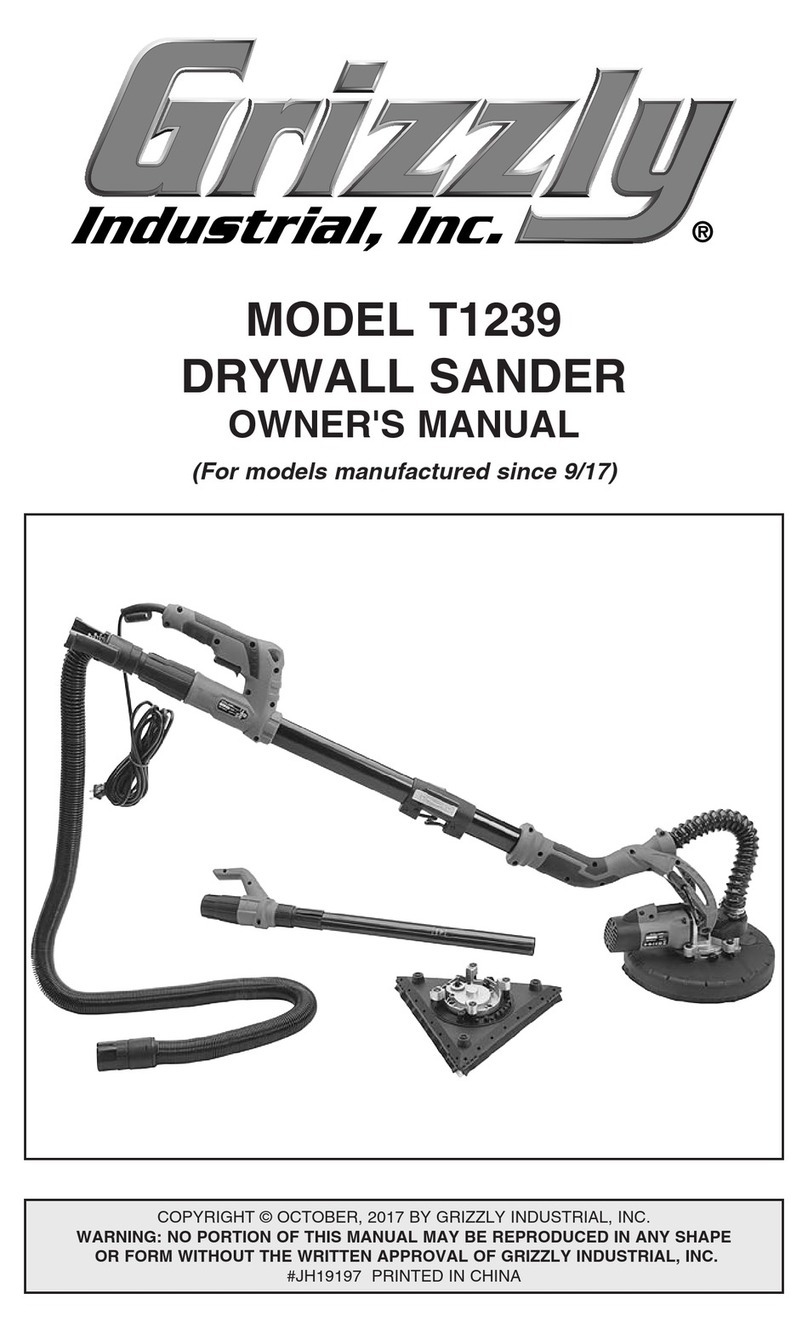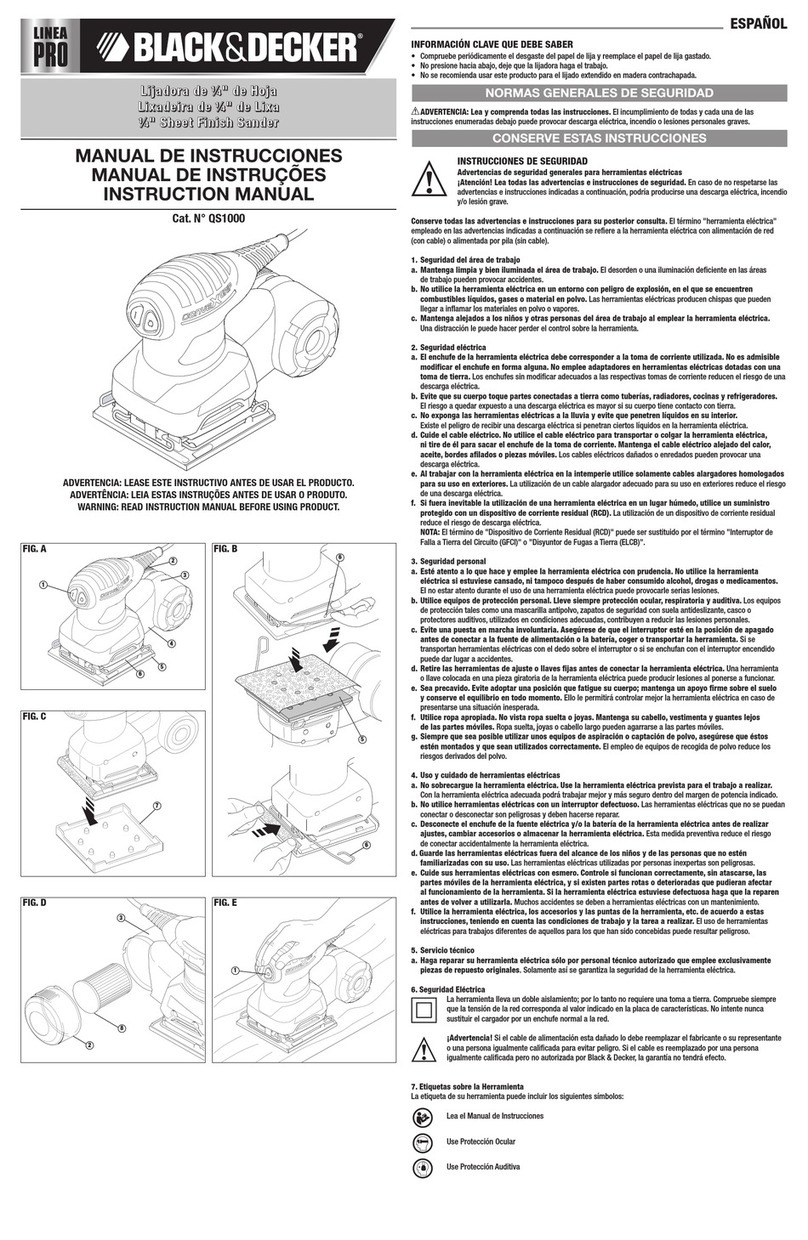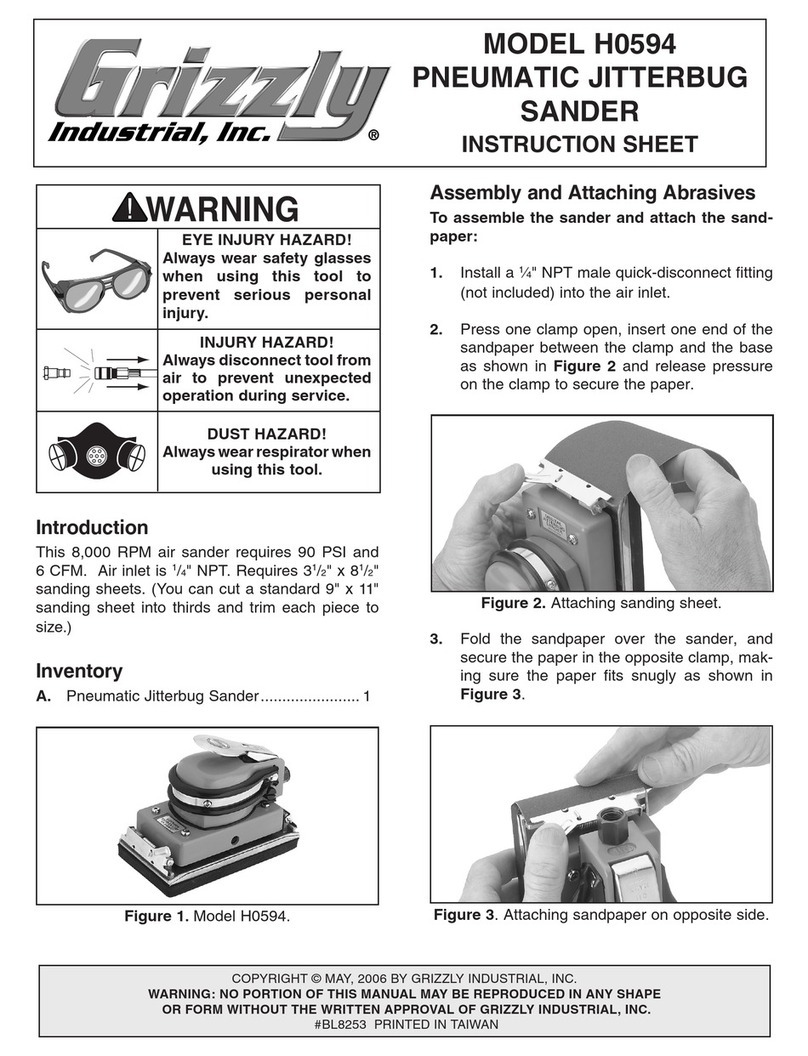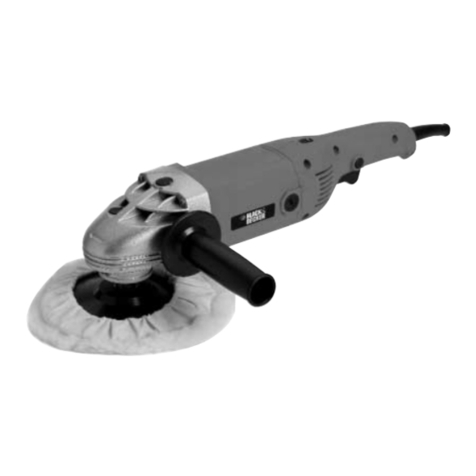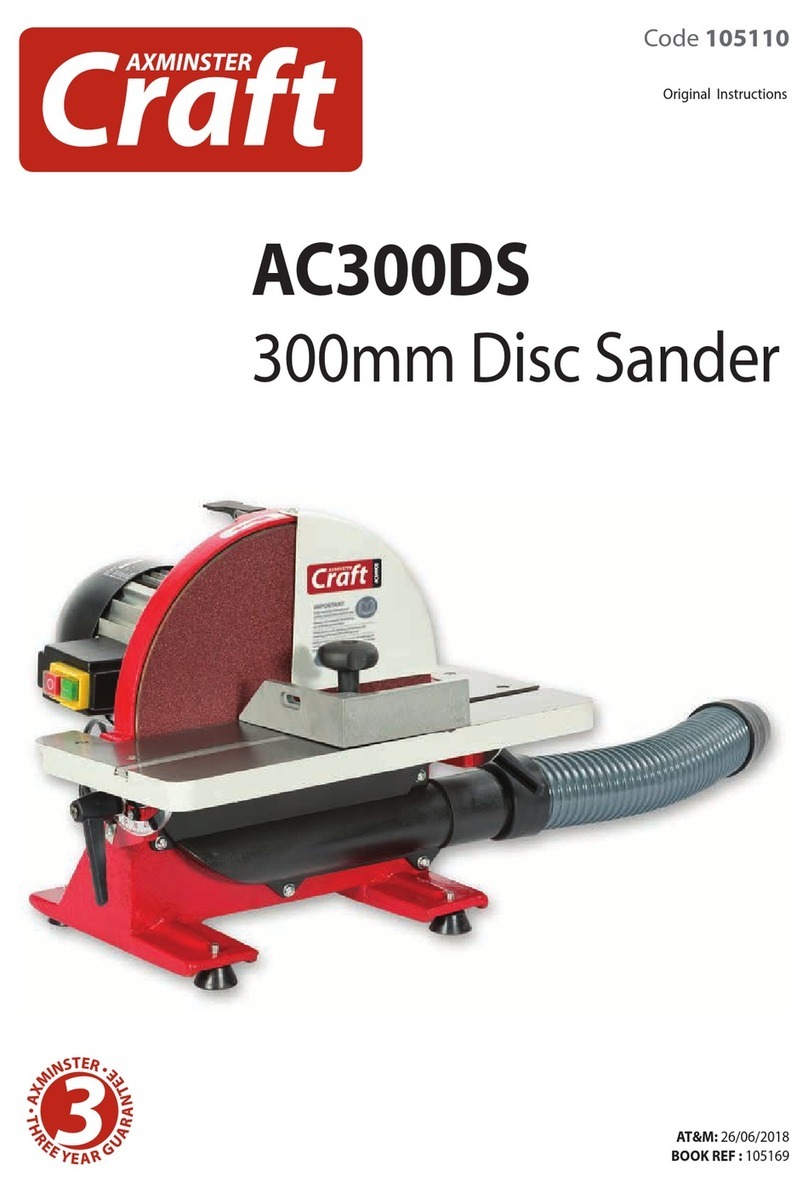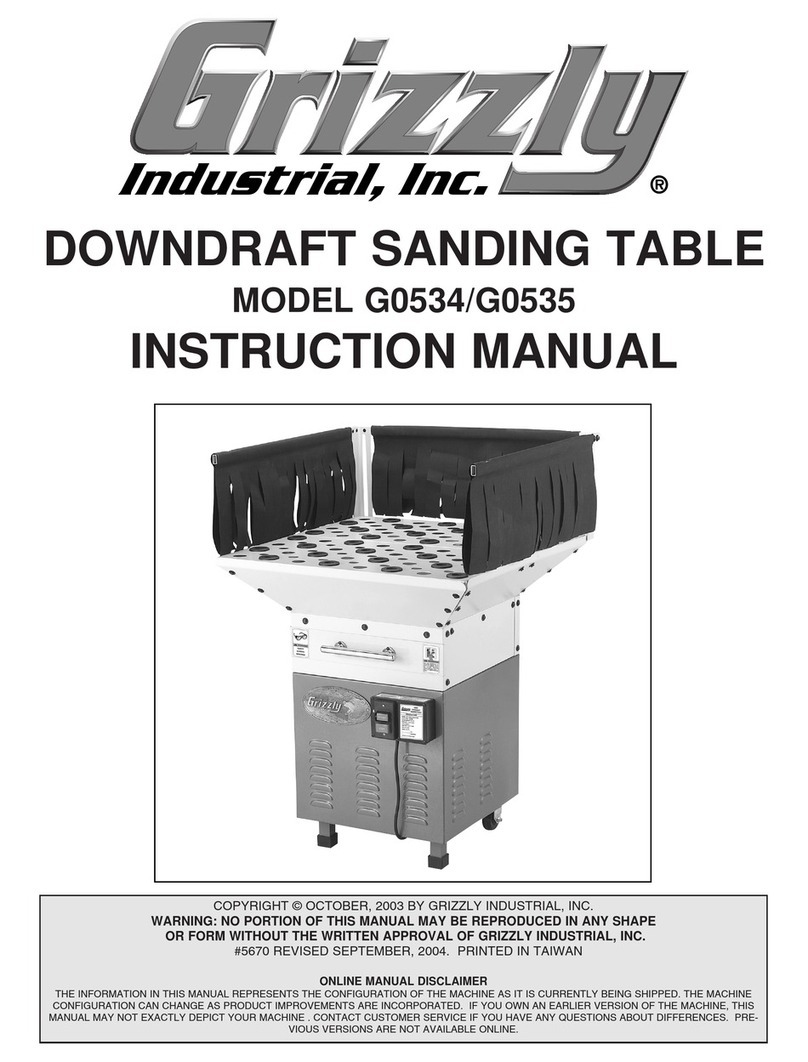TOOLSPACE XW-1204 User manual

Model: XW-1204
12V CORDLESS POLISHER

Dear Customer,
Thank you for your purchase.
Your purchase means the world to us.
If you have any questions, we are here to service you.
lf the product you received is damaged or has quality
problems, please contact us through Email below and
attach product pictures of related problems,we will
reply to you as soon as possible,and provide you with
the best solution.
Email: TOOLSPACE01@outlook.com
Best regards,
Toolspace Customer Service Team

1
2
3
4
5
6
7
8
9
10
11
12
1
13
14
Check the actual product for detail attachment.

5
7
6
A
13 1
C
12
E
7
8
9
B
14
D
1 2
2
F

Scope of delivery / Part list
Safety
1. Spindle lock button
2. Speed selector switch
3. Battery level indication
4. Shift lock
5. Handle
6. Battery latch
7. Battery
8. Charger
9. Charge indicator lamp
10. Polishing attachment
11. Sanding paper
12. On/Off switch
13. Polishing / grinding plate
14. Additional handle
Reading and storing the user manual
This user manual is an integral part of this 12 V Li-Ion cordless polishing machine
(hereafter referred to only as the "polishing machine" or "product"). It contains important
information on safety, usage and maintenance. Please read the user manual carefully
before using the polishing machine. Pay particular attention to the safety instructions
and warnings. Failure to follow the instructions given in this manual may result in
serious injury or damage to the polishing machine. Always include the user manual
when you give the polishing machine to others. Keep this manual in a safe place for
future reference. The digital form of this operating manual is also available from the
service department of the manufacturer.
Proper use
The polishing machine is intended for private
and DIY use only for the following purposes:
-For polishing painted surfaces;
-For sanding wood, plastic and other similar
materials using a suitable sanding paper.
All other applications are expressly ruled out
and are considered as unintended use. The
manufacturer cannot be held responsible for
damage or injury caused by misuse of the
product. Examples of misuse are given in the
following non-exhaustive list:
- Using unsuitable accessories
- Using non-original spare parts.
- Incorrect operation or misuse.
- Non-observance of the operating manual.
- Repairs performed by unauthorised third
party workshops.
- Power cuts or faults caused by non-
observance of electrical regulations.
- Use and maintenance of the polishing
machine by someone who is not familiar with
the polishing machine and/or who lacks
suitable experience.
- Commercial, non-industrial or industrial use
of the polishing machine.
Use the accessories according to these
instructions. Failure to follow the instructions
given in this user manual may result in
serious injuries and loss of warranty. Comply
with applicable local or national regulations
concerning the use of this polishing machine.
Do not make any modifications to the polishing
machine. Any modification to the polishing
machine may be dangerous and is prohibited.
Residual risk
Residual risks cannot be completely ruled out
even in case of proper use. Due to the nature of
the polishing machine, the following risks may
arise:
- Health issues resulting from vibration, if the
cordless polishing machine is used for an
extended period of time, or is not operated
and maintained properly,
- Injury and property damage caused by parts
flung out or tool attachment breakage,
- Health hazards as a result of working with
toxic or harmful materials (e.g. asbestos).

General safety instructions for
power tools
WARNING!
Read all the warnings and safety
instructions carefully.
Failure to follow the
warnings and safety instructions may result
in electric shock, fire and/or serious injuries.
Retain all the warnings and safety
instructions for future reference.
The term "power tool" in the safety
instructions refers to your mains-operated
(corded) power tool or battery-operated
(cordless) power tool.
1) Work area safety
a) Keep your work area clean and well lit.
Disorderly or inadequately lit work areas
can lead to accidents.
b) Do not work with the power tool in
potentially explosive atmospheres
containing flammable liquids, gases or
dusts.
Power tools create sparks which
may ignite the dust or fumes.
c) Keep children and other people out of
the area when operating the power tool.
Distractions can cause you to lose control
of the power tool.
2) Electrical safety
a) The power tool's mains plug has to
fit the socket. The plug should not
be modified in any way. Do not use
any adapter plugs with the earthed
(grounded) power tools.
Unmodified
plugs and matching sockets will reduce
risk of electric shock.
b) Avoid bodily contact with earthed
objects such as pipes, radiators, ovens
and refrigerators.
There is an increased
risk of electric shock when your body is
earthed.
c) Keep power tools out of rain and wet
environments.
Water entering a power
tool will increase the risk of electric
shock.
d) Do not use the power cord for purposes
for which it is not intended, such as
carrying or hanging up the power tool,
and do not pull the cord to disconnect
the tool from the mains. Keep the power
cord away from heat, oil, sharp edges
or moving parts.
Damaged or entangled
power cords increase the risk of electric
shock.
e) When operating the power tool
outdoors, use only extension cords
suitable for outdoor use.
Using an
extension cord suitable for outdoor use
reduces the risk of electric shock.
f) If you need to use the power tool in
a damp environment, use a residual
current protection device.
Using a
residual current protection device reduces
the risk of electric shock.
3) Personal safety
a) Stay alert, watch what you are doing
and use common sense when operating
a power tool. Do not use a power
tool while you are tired or under
the influence of drugs, alcohol or
medication.
A moment of inattention
while operating power tools may result in
serious injury.
b) Wear personal protective equipment and
always use safety goggles.
Protective
equipment such as dust mask, non-
skid safety shoes, hard hat, or hearing
protection used for appropriate conditions
will reduce personal injuries.
c) Prevent unintentional start-up. Ensure
the switch is in the off-position before
connecting to power source and/or
battery pack, picking up or carrying the
tool.
Carrying power tools with your finger
on the switch or connecting it to the
mains with the switch in on-position, may
result in accidents.
d) Remove any adjusting tools or keys
before you switch the power tool on.
A

tool or a key left in a rotating part of the
power tool may result in injuries.
e) Avoid working with your body in an
unusual position. Ensure proper footing
and balance at all times.
This enables
better control of the power tool in
unexpected situations.
f) Wear appropriate clothing. Do not wear
loose clothing or jewellery. Keep your
hair and clothing away from moving
parts.
Loose clothes, jewellery or long
hair can be caught in moving parts.
g) If dust extraction and collection
units can be installed, they have to be
connected and used properly.
Use of dust
collector can reduce dust-related hazards.
4) Power tool use and care
a) Do not overload the power tool. Use
power tools that are intended for your
work.
The correct power tool will do the
job better and safer at the rate for which it
was designed.
b) Do not use the power tool if the switch is
faulty.
A power tool which can no longer
be switched on and off is dangerous and
has to be repaired.
c) Disconnect the plug from the socket
and/or remove the battery before
making any adjustments, changing
tool bits or accessories or putting the
power tool away.
Such preventive safety
measures reduce the risk of starting the
power tool accidentally.
d) Store power tools out of the reach of
children when not in use. Do not allow
persons unfamiliar with the power tool
or these instructions, to operate the
power tool.
Power tools are dangerous in
the hands of inexperienced users.
e) Maintain the power tools and tool bits
carefully. Ensure the moving parts are
functioning correctly and do not getting
stuck. Check if parts are broken or so
badly damaged that that the power
tool's functions are impaired. Get
damaged parts repaired before using the
power tool.
Many accidents are caused by
poorly maintained power tools.
f) Keep cutting tools sharp and clean.
Properly maintained tools with sharp
cutting edges are less likely to get stuck
and are easier to control.
g) Use your power tool, accessories and
bits etc. according to these instructions.
Consider your working environment and
the type of job you wish to do.
Using
power tools for applications other than
those intended can lead to dangerous
situations.
5) Usage and handling the cordless power
tool
a) Charge batteries only using chargers
recommended by the manufacturer.
Charging batteries in a charger intended
for other types of battery can result in fire.
b) Use only batteries designed for use with
the power tool.
The use of other batteries
can lead to injury or fire.
c) When not in use, keep the battery away
from staples, coins, keys, nails, screws
or other metal objects which could
bridge the contacts on the battery.
A
short circuit between the battery contacts
can lead to burns or fire.
d) Fluid can leak from the battery if the
machine is used incorrectly. Avoid any
contact with any fluid which may leak
from the battery. Wash your skin with
water should the fluid come into contact
with your skin. Should the fluid come
into contact with your eyes, rinse with
water and seek medical attention.
Fluid leaking from batteries can lead to
irritation or burns.
6) Service
a) Have your power tool repaired only
by qualified personnel and only with
original spare parts.
This will ensure that
the safety of the power tool is maintained.

Safety instructions for all
applications
a) This power tool is designed for use
as a sander and polishing machine.
Read all safety warnings, instructions,
illustrations and specifications
provided with this power tool.
Failure
to follow all instructions listed below
may result in electric shock, fire and/or
serious injury.
b) This power tool is not suitable for
grinding, working with wire brushes
and cutting.
Using the power tool for
other purposes than it is designed for
can cause danger and injuries.
c) Do not use accessories which
are not specifically designed
and recommended by the tool
manufacturer.l.
Just because the
accessory can be attached to your power
tool, it does not assure safe operation.
d) The permissible speed of the tool has
to be at least equal to the maximum
speed specified on the power tool.
Accessories running faster than their
rated speed can break and fly apart.
e) Outer diameter and thickness of the
tool have to match the dimensional
specifications of your power tool.
Incorrectly sized accessories cannot be
adequately guarded or controlled.
f) Tool bits with threaded insert have
to exactly match the threads of the
grinding spindle. When using tool
bits, which are mounted using the
flange, the hole diameter of the tool
bit has to match the diameter of the
flange.
Tool bits that are not fixed
properly to the power tool will rotate
unevenly, vibrate excessively and may
cause loss of control.
g) Do not use damaged tool bits. Before
each use inspect the accessory such as
abrasive wheels for chips and cracks,
backing pads for cracks, tear or excess
wear, wire brushes for loose or cracked
wires. If power tool or application tool
(planer blade) is dropped, inspect
for damage or install an undamaged
application tool. After inspecting
and installing the tool bit, position
yourself and bystanders away from the
plane of the rotating tool and run the
power tool at maximum no-load speed
for one minute.
Damaged accessories
will normally break apart during this
test time.
h) Wear personal protective equipment.
Depending on application, use face
shield, safety goggles or safety
glasses. As appropriate, wear dust
mask, hearing protectors, gloves
and workshop apron capable of
stopping small abrasive or workpiece
fragments.
The eyes have to be
protected from foreign objects that are
generated and ejected by the various
applications. The dust mask or respirator
must be capable of filtrating particles
generated by your operation. Prolonged
exposure to high intensity noise may
cause hearing loss.
i) Keep others at a safe distance from
your work area. Anyone entering
the work area must wear personal
protective equipment.
Fragments of
the workpiece or of a broken tool may
be thrown out and cause injury beyond
immediate area of work.
j) Hold the power tool only by its
insulated gripping surfaces when
performing an operation where
the fitted accessory may contact
hidden wiring or its own cord.
Cutting
accessory contacting a "live" wire may
make exposed metal parts of the power
1) General safety instructions for
sanding and polishing:

tool "live" and shock the operator.
k) Never put the power tool down before
the tool bit stops completely.
The
spinning accessory may grab the surface
and pull the power tool out of your
control.
l) Do not allow the power tool to run
while carrying it.
Accidental contact
with the spinning accessory could snag
your clothing, pulling the accessory into
your body.
m) Clean your power tool’s ventilation
slots regularly.
The motor’s fan will
draw the dust inside the housing and
excessive accumulation of powdered
metal may cause electrical hazards.
n) Do not operate the power tool near
flammable materials.
Sparks could
ignite these materials.
o) Do not use tool bits that require liquid
coolant.
Using water or other liquid
coolants may result in electrocution or
shock.
Additional safety instructions for
all applications
Kickback is a sudden reaction to a pinched
or snagged rotating tool bit such as
sanding disc, sanding pad, wire brush etc.
Snagging or blocking causes the rotating
tool bit to stop abruptly. This in turn causes
the uncontrolled power tool to be forced
in the direction opposite to the tool bit’s
rotation at the blocked point.
For example, if an abrasive disc is snagged
or pinched in the workpiece, the edge of
the disc that is entering into the pinch
point can dig into the surface of the
material causing the disc to climb out or
1) Kickback and corresponding safety
instructions:
kick out. The disc may either jump toward
or away from the operator, depending on
direction of the disc’s movement at the
point of pinching. Abrasive discs may also
break under these conditions.
Kickback is the result of using the power
tool in an incorrect or improper manner.
Kickback can be avoided by taking
appropriate precautions, as described
below:
a. Maintain a firm grip on the power
tool and position your body and arm
to allow you to resist kickback forces.
Always use the additional handle, if
provided, for maximum control over
kickback or torque reaction during
start-up.
The operator can control
torque reactions or kickback forces, if
proper precautions are taken.
b. Never place your hand near the rotating
tool bit.
Accessory may kickback over
your hand.
c. Do not position your body in the area
where power tool will move if kickback
occurs.
Kickback will propel the tool
in direction opposite to the disc’s
movement at the point of snagging.
d. Use special care when working corners,
sharp edges etc. Avoid bouncing and
snagging the accessory.
Corners, sharp
edges or bouncing have a tendency to
snag the rotating accessory and cause
loss of control or kickback.
e. Do not use chains or serrated saw
blades.
Such tool bits frequently cause
kickback and loss of control over the
power tool.

Additional safety instructions for
sanding
Additional safety instructions for
polishing
a. Do not use excessively oversized
sanding disc paper. Follow
manufacturers recommendations,
when selecting sanding paper.
Larger
sanding paper extending beyond the
sanding pad presents a laceration hazard
and may cause snagging, tearing of the
disc or kickback.
a. Do not leave any loose parts of the
polishing cover, especially fastening
cords. Stow or shorten the fastening
cords.
Your fingers or the workpiece may
get caught in loose, rotating fastening
cords.
Safety instructions for chargers
a) Never connect a battery pack that is
damaged in any way to the charger.
There is a danger of electric shock.
b) Do not misuse the charger! The charger
is only intended for charging the
battery pack Mod. XW-120302C, 2000
mAh. Misuse may result in fire or a fatal
electric shock.
c) WARNING! Do not charge non-
rechargeable batteries with the
charger. Not following this instruction
results in hazards.
d) Damaged mains plug or connecting
cables have to be replaced by the
manufacturer of the power tool or
his customer service department to
prevent hazards.
e) The charger, but not the cordless
drill, can be operated by children
from 8 years of age and above, as well
as by people with reduced physical,
sensory or mental capacities or who
lack knowledge or experience, if they
have been supervised or instructed
regarding safe use of the device, and
understand the resultant dangers.
Children should not play with the
device. Cleaning and user maintenance
shall not be performed by children
without supervision.
f) Do not expose the cordless drill and
the charger to rain or moisture. Water
ingression can result in an electrical
shock and damage the device.

Checking the product and scope of
delivery
Before Use
WARNING!
Do not use the polishing machine in
potentially explosive atmospheres.
Use the polishing machine only in
ambient temperatures between 10 -
40°C.
Disconnect the polishing machine
from the power source before
making any settings, mounting or
replacing accessories and carrying out
maintenance.
• Take the polishing machine and accessories
out of the packaging
• Check that the delivery is complete (see
section “Scope of delivery / Description of
parts”).
• Check the polishing machine and accessories
for damages.
• Do not use the polishing machine if it is
damaged or parts are missing. Contact the
manufacturer via the service centre listed on
the warranty card.
WARNING!
Risk of suffocation! There is a risk of
suffocation by ingestion or inhalation of
films. Keep the packaging film out of the
reach of children.
Inserting /removing the battery
(Fig. A)
• Insert the battery 7into the handle 5
until it locks in place.
• To remove the battery, press the battery
unlocking latch 6and slide the battery out
of the handle.
• Remove the battery 7from the handle, as
described in chapter "Inserting / Removing
the battery".
• Insert the battery into the battery holder of
the charger 8.
• Connect the plug of the charger to a suitable
mains socket. The red charging light 9
is on.
• After about 3 - 5 hours, the red charging
indicator light goes out. The green charging
indicator light lights up when the charging is
completed.
• Disconnect the charger from the mains socket
after charging is complete.
• To remove the battery, press the battery
release button and take it out of the charger.
NOTE!
Ambient temperature for operation:
10 - 40° C.
Charging the battery (Fig. B)
NOTE!
Ambient temperature for charging: 0 - 40° C
Use only the batteries mentioned below:
Model XW-1204
Rated voltage 12 V
Capacity 2000 mAh
Idling speed 1. Speed 0 - 2600 rpm
2. Speed 0 - 7800 rpm
CAUTION!
When charging and during high loads on
the polishing machine, the battery gets
heated up. Always allow the battery to
cool down to room temperature before
you charge the battery.
The charger becomes warm and may buzz
slightly during charging. This is normal
and does not indicate a fault.

WARNING!
For safety reasons the additional handle
14 should always be used.
Mount the sanding or polishing
attachment mount (Fig. C)
Mounting / removing the
additional handle (Fig. D)
Checking the battery level
To check the charging status, the battery level
indicator
3
lights up when you press the on /
off switch.
The charging status is indicated as follows:
- All 3 LEDs light up: Battery is charged
- 2 LEDs light up: Battery is partially charged
- 1 LED lights up: Battery needs to be charged
The additional handle is provided with an external
thread.
• Push the spindle lock button up
1
.
• Mount the polishing / sanding plate
13
by
turning it clockwise.
• Select the appropriate sanding or polishing
attachment.
• To remove proceed in the reverse order.
• Fix the additional handle in clockwise direction
to the left or right on the top of the tool
depending on the work.
The speed can be infinitely adjusted by varying
the pressure exerted on the trigger.
NOTE!
Ensure that the tool shaft and the tool
holder are free from dust and lightly grease
the shaft before inserting it into the chuck.
This extends the service life of the chuck and
the polishing machine.
NOTE!
Check the battery level regularly to avoid
deep discharges.
NOTE!
The polishing machine is locked if the shift
lock
4
is on the right side.
NOTE!
Change speeds only when the drill spindle
has come to a complete stop. (Risk of
damage to the gears)
Use
Switching on / off (Fig. E)
Speed selection (Fig. F)
Switching on:
• Press the On / Off switch
12
.
Switching off:
• Release the On / Off switch.
Speed selection switch in position 1:
• 1. Speed (marked as L for low speed) 0 - 2600
rpm
Speed selection switch in position 2:
• 2. Speed (marked as H for high speed) 0 -
7800 rpm
Always ensure that the speed selection
switch
2
properly locks into position 1
or 2.

NOTE!
Only use special wax and polish suitable for
machines. Make sure that the workpiece to
be machined never comes into contact with
the polishing / grinding plate.
Sanding and polishing
• Mount the required sanding attachment on the
polishing / sanding plate.
• Switch on the product and run it with moderate
pressure on the workpiece using circular,
transverse or longitudinal movements.
• Mount the required polishing attachment
10
on the polishing / sanding plate.
• Make sure that the selected polishing
attachment is not contaminated and always
mounted exactly in the centre on the polishing
/ sanding plate.
• Check if the polishing attachment is firmly
attached before switching on.
• Switch on the product and run it with moderate
pressure on the workpiece using circular,
transverse or longitudinal movements.
Sanding
Polishing
For sanding, use the appropriate sanding papers
11
. The various sanding attachments are easy to
change by means of the Velcro.
For rough finish, a coarse grit and for fine finish
a fine grit is recommended. The optimum grit can
be determined by carrying out a sanding test.
For polishing, use the appropriate polishing
attachments
10
. The various polishing
attachments are easy to change by means of the
Velcro.
Work instructions
CAUTION!
Do not apply excessive force on the
product.
Excessive pressure may damage
the product or its accessories and increases
the risk of injury.
For this reason is it
important to always grip the product
firmly with two hands and maintain a
stable posture.
Always secure your workpiece in a vice or
in any other clamping device for sanding.
Secure particularly large workpieces
against sliding or support them properly.
Selecting the appropriate sanding
as you need

• Clean the polishing machine with a moist cloth.
Never use strong and / or abrasive cleaning
agents or solvents. Allow all the parts to dry
completely.
• The contact points on the battery and charger
have to be kept clean. Disconnect the charger
by unplugging it from the power supply before
cleaning. Remove the battery before cleaning
the polishing machine.
• Ensure that the ventilation slots are not
blocked and clean the housing of the polishing
machine regularly with a soft cloth.
• Remove the attachment before storage (see
chapter "Mounting the sanding or polishing
attachment").
• Remove the battery before putting the drill
away (see chapter "Inserting / removing the
battery").
• Clean the polishing machine before storage.
• If the polishing machine is not being used,
keep it in a safe, cool, dry and well-ventilated
place, out of the reach of children.
• Store the polishing machine and the battery at
an ambient temperature of 0 - 45° C.
• Store the accessories after use in the storage
case.
• Make it that the polishing attachment rests
completely on the polishing surface.
• Glue plastic parts to avoid colour changes.
• Polish in the shade and never polish hot
varnish.
CAUTION!
When charging and during high loads on
the polishing machine, the battery gets
heated up. Always allow the battery to
cool down to room temperature before
you charge the battery.
Make sure that liquids do not get inside
the polishing machine.
Tips for polishing
Maintenance, cleaning,
storage and transport
WARNING!
Disconnect the mains plug of the
charger and remove the battery of the
polishing machine before carrying out
any adjustment, maintenance, repair
or cleaning. To do this, remove the tool
being used.
Maintenance
Cleaning
Cleaning
The polishing machine requires very little
maintenance.
Only use spare parts / accessories from the
manufacturer or authorised and qualified
workshops.
Repairs should only be carried out by qualified
technicians or by an authorised service centre.
Qualified technicians must have relevant
training and experience, be familiar with the
design and construction requirements of the
product and understand and follow the safety
regulations.
• Remove the attachment before transport (see
chapter "Mounting the sanding or polishing
attachment").
• Remove the battery before transporting the
drill (see chapter "Inserting / removing the
battery").
• Always carry the polishing machine using the
handle provided for this purpose.
• Use the original packaging and secure the
polishing machine in place during transport.
Transport

Troubleshooting
Problem Possible cause Rectification
Polishing machine does
not start.
Battery empty. Charge the battery.
Problem with battery contacts. Slide the battery into the guide on the
polishing machine handle. The battery
has to click into place audibly.
Shift lock is in locked position. Press the shift lock 4to the left to
unlock it.
Polishing machine
is running but the
polishing / sanding
plate is not rotating.
Speed switch is not engaged. Press the speed switch 2to position 1
or 2 until it engages fully.
Battery does not
charge.
Battery charger is faulty. Replace the charger.
WARNING!
Safety measures have to be defined
to protect the operator based on an
estimate of the vibration load during
actual usage conditions (in this case all
the parts of the operating cycle have to
be considered, such as times when the
power tool is turned off, and those where,
the tool is turned on, but is running
without load).
Depending on the way the tool is used
and the operating conditions, the
following safety precautions have to be
taken for the safety of the operator:
- Try to avoid exposure to vibration as much as
possible.
- Only use proper accessories.
- Wear anti-vibration gloves when using the
polishing machine.
- Follow the instructions on maintenance and
care of the polishing machine given in this
manual.
- Avoid using the polishing machine at a
temperature below 10°C and over 40°C.
- Plan your work in such a way so that you do
not have to use vibrating tools over several
days.

Disposal of packaging
Dispose of packaging separately.
Dispose of card and paper in waste
paper, plastic at collection points.
Disposal of the product
Disposal of batteries /
accumulators
The symbol with crossed-out dustbin on
batteries and accumulators indicates
that they should not be disposed of
along with household waste at the end
of their service life. If the batteries or
accumulators contain mercury (Hg), cadmium
(Cd) and lead (Pb), you can find the respective
chemical symbol below the crossed out dustbin.
Check the local and national regulations if
there is a legal obligation to return used
batteries and accumulators after use. You can
do this mostly free of charge at the retailer
or in another collection centre near you. The
addresses of appropriate collection points
can be obtained from your city or municipal
authorities.
Batteries may contain substances that are
harmful to the environment and human
health. Be very careful when handling lithium-
containing batteries because of the specific
risks. The separate collection and recycling
of used batteries and accumulators prevents
adverse effects on the environment and human
health.
Please avoid generating waste from used
batteries as much as possible, e.g. by preferring
batteries with a longer service life or using
rechargeable batteries. Please avoid littering
public places by not carelessly leaving batteries
or electrical and electronic equipment
containing batteries. Please consider ways to
reuse a battery instead of disposing of it, such
as reconditioning or repairing the battery.
This symbol indicates that this product
may not be disposed of together with
domestic waste in compliance with the
(2012/19/EC) directive pertaining to
waste electrical and electronic devices
(WEEE). This product should be handed over at
an designated collection point. This can occur,
for example, by returning it when a similar
product is purchased or by handing it in at an
authorised collecting point for the recycling of
waste electrical and electronic equipment.
Owing to potentially hazardous substances that
are frequently contained in waste electronic
equipment, incorrect handling of waste
equipment may have a negative impact on the
environment and on the health of human
beings. By disposing of this product correctly,
you are also contributing towards an efficient
use of natural resources. Information on
collection points for used equipment can be
obtained from your local authority, the public
waste disposal authority, an authorised
institution for the disposal of used electrical
and electronic equipment or the waste
collection services. Dispose of the product and
packaging in an environmentally friendly
manner.
Remove the battery before disposing the
product.
Recycling
Table of contents
Popular Sander manuals by other brands
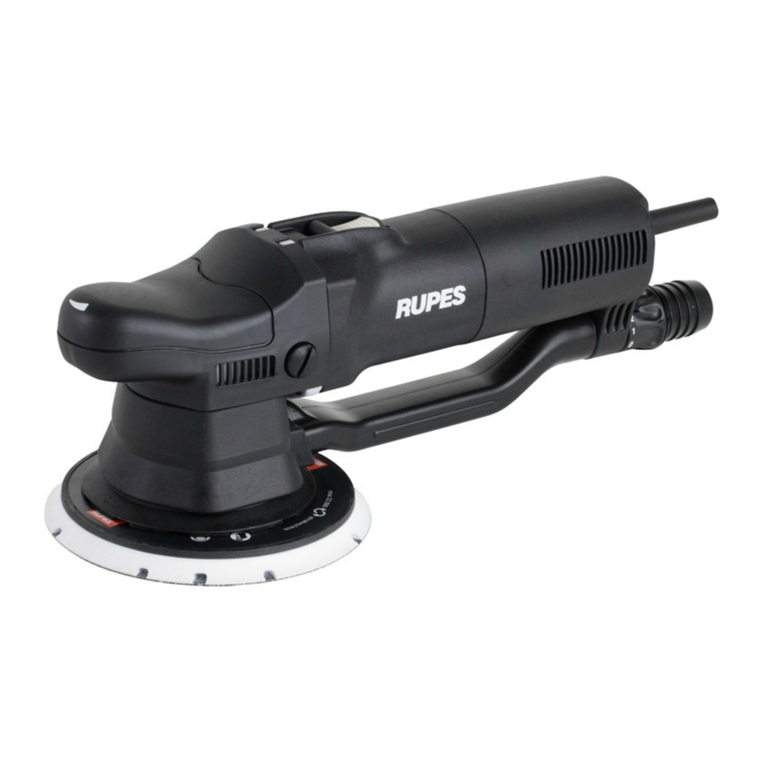
Rupes
Rupes BR106AE Operating and maintenance instructions

Powermatic
Powermatic OES9138 Operating instructions and parts manual

Bosch
Bosch 1294VSK Operating/safety instructions

Makita
Makita DPO500 instruction manual

Milwaukee
Milwaukee POS 13 Original instructions

Chicago Electric
Chicago Electric 90820 Assembly and operating instructions
